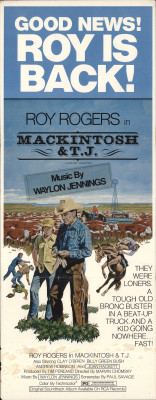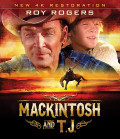| Reviews & Columns |
|
Reviews DVD TV on DVD Blu-ray 4K UHD International DVDs In Theaters Reviews by Studio Video Games Features Collector Series DVDs Easter Egg Database Interviews DVD Talk Radio Feature Articles Columns Anime Talk DVD Savant Horror DVDs The M.O.D. Squad Art House HD Talk Silent DVD
|
DVD Talk Forum |
|
|
| Resources |
|
DVD Price Search Customer Service #'s RCE Info Links |
|
Columns
|
|
|
Mackintosh and TJ
Are there any film and television stars working today as positively beloved as Roy Rogers once was?
Born Leonard Slye, Rogers co-founded the Sons of the Pioneers singing cowboys group, then eased into B-Westerns, eventually replacing Gene Autry as Republic Studios' top star in that capacity when Autry joined the Army in 1942. Rogers stopped making B-Westerns in 1952, his The Roy Rogers Show TV program debuting at the end of 1951 and which CBS continued airing in reruns until the fall of 1964, seven years after it had ended. During that time, Rogers (and his wife and co-star, Dale Evans) amassed a fanbase of millions of kids, loyal fans even we they outlived Roy and Dale and became parents and grandparents themselves.
Rogers gave up film acting, apart from a cameo in the Bob Hope comedy Alias Jesse James (1959), the couple preferring to focus on their church work, they being particularly devout Christians. (Roy's son, Roy, Jr., and previous wife, Grace both died within days after Roy Jr.'s birth.)
Nearly a quarter-century after his last starring film, 63-year-old Roy returned to the screen one last time for Mackintosh and TJ (1975), a surprisingly effective modern Western striking an agreeable middle-ground between Roy's clean-cut image and ‘70s-era filmmaking. While it's not a great work of cinematic art, it is pleasant with much to recommend it, and it holds up surprisingly well today.
Mackintosh (Rogers) is an aging, unemployed cowboy driving across Texas in his battered Chevy pickup looking for work. Passing through one dusty town he encounters 14-year-old TJ (Clay O'Brien), the boy effectively homeless, and Mackintosh intercedes when the boy is about to be caught shoplifting apples from a local grocer. Mackintosh and TJ become friends, the pair eventually traveling together and landing jobs at the 6666 Ranch. Despite Mackintosh's age, the other cowboys are impressed he can still break horses, dangerous and physically exhausting work. Later, when a farmhand (Ted Gehring) whose job it is to hunt coyotes on the ranch is bit and develops rabies, Mackintosh takes over that thankless, lonely job, he and TJ moving to the hunter's filthy, remote cabin.
The movie isn't so much a Roy Rogers movie of old as much as a modern Western that happens to star him. The movie would have been fine with another actor playing Mackintosh; Ben Johnson comes to mind. Though Roy's screen image remains intact -- at a bar he orders coffee, for instance -- it's not at all sickly-sweet.
Indeed, what story there is beyond the relationship between Mackintosh and TJ concerns, of all things, a Peeping Tom, a cowhand named Coley Phipps (Andrew Robinson, demoted in the world of crime from serial killer Scorpio in Dirty Harry), obsessed with Maggie (Joan Hackett), the abused wife of another cowboy, Luke (Billy Green Bush), who's insanely jealous.
What most impresses about Mackintosh and TJ is its authentic-seeming portrait of modern cowboy life. Filmed at a real ranch also called "6666," it offers interesting location scenes inside a real bunkhouse, a storage facility where hands can pick up dry and canned goods, while the movie shows these cowboys doing everyday work that's anything but glamourous. Robinson's Phipps, for instance, mainly fixes mechanical stuff like the many windmills on the expansive ranch, while others tend to mending barbed-wire fences and the like. In Roy's scenes with the owner, played by Walter Barnes, their discussions about pay and modern cowboy life have a real verisimilitude.
Into all this Roy blends quite nicely. Showing his age but still in good shape, Roy's Mackintosh, with his polite, easy-going demeanor, is completely believable as an aging cowhand struggling to find work as his advancing years and a declining chosen profession that steadily marginalizes him. In some ways the film even resembles the recent Nomadland, with Mackintosh driving around an economically depressed American West, living mostly out of his pickup (itself on its last legs), grabbing up short-term work wherever he can find it.
The heart of the film, the relationship between the old cowboy and the young drifter, also mostly works because it avoids sentimentality and clichéd generation-gap conflict. TJ likes Mackintosh because he treats him like an adult, and TJ recognizes Mackintosh's wisdom, developed through his life experiences. And there are some surprises. When TJ comments about admiring all the photos of nude women in Phipps's room, Mackintosh sets TJ straight on the objectification of women. (Roy Rogers a feminist? Who'd have thunk it?)
The film was obviously made on a modest budget but never looks cheap. The well-chosen cast is populated with good actors like Hackett, James Hampton, Edith Atwater in addition to those mentioned above. Some aspects might have been better. Joan Hackett's abused wife, who tries striking up a friendship with Mackintosh, is underdeveloped, though Hackett is very good. Hampton's character, a friend of the abusive husband, makes several decisions with disastrous consequences that seem unmotivated unless one chooses to read a really buried homosexual subtext probably not intended.
As TJ, Clay O'Brien is good but his dialogue is often not very natural. He was already something of a genre veteran at 14, having already appeared in The Cowboys and Cahill U.S. Marshal with John Wayne, and One Little Indian, a forgotten Disney Western comedy starring James Garner. He appeared on Gunsmoke and was a regular on another series, The Cowboys, based on the earlier film. And just before this O'Brien played one of the three kids at the center of The Apple Dumpling Gang, a big hit for Disney.
Video & Audio
An MVD Visual release, Mackintosh and TJ (which is how the title onscreen reads) is presented in a full-screen, 1.78:1 transfer approximating its original 1.85:1 theatrical version. Essentially "four-walled" (self-distributed), the film fell into obscurity but producer Steve Latshaw nonetheless gives the film a full-on 4K restoration, and it's a thing of beauty, a nearly flawless, pristine presentation. The LPCM 2.0 mono is also way above average. English subtitles are provided on this Region "A" disc.
Extra Features
Supplements are all COVID-restricted stuff, with everything done on Zoom. Clay O'Brien, Andrew Robinson, and Larry Mahan join C. Courtney Joyner and Steve Latshaw for a "Lone Pine Cast Reunion" (as well as an audio commentary track) while Billy Green Bush is interviewed in a separate Zoom call. A vintage behind-the-scenes has poor video quality but is still a welcome extra, and a trailer is also included.
Parting Thoughts
Better than a mere curiosity, Mackintosh and TJ is a most welcome release and for Western genre fans Highly Recommended.
Stuart Galbraith IV is the Kyoto-based film historian largely absent from reviewing these days while he restores a 200-year-old Japanese farmhouse.
|
| Popular Reviews |
| Sponsored Links |
|
|
| Sponsored Links |
|
|
| Release List | Reviews | Shop | Newsletter | Forum | DVD Giveaways | Blu-Ray | Advertise |
|
Copyright 2024 DVDTalk.com All Rights Reserved. Legal Info, Privacy Policy, Terms of Use,
Manage Preferences,
Your Privacy Choices | |||||||














